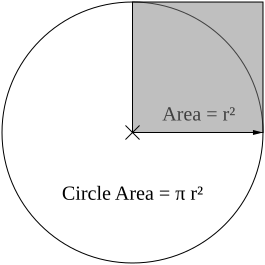For those not mathematically inclined, 3.14 is the ratio of a circle's circumference to its diameter (Circum. = 3.14 x d). Pi is also the ratio of a circle's area to the square of
 its radius (Area = 3.14 x r2). Pi, represented by the Greek letter to the right, is one of the most
its radius (Area = 3.14 x r2). Pi, represented by the Greek letter to the right, is one of the most  important mathematical constants out there.
important mathematical constants out there.People have been able to memorize more and more digits of pi - while 3.14 suffices for the casual user, and 3.14159 works for more technical applications, some have memorized tens of thousands of decimal places. According to the Guiness Book of World Records, 24-year-old Chinese graduate student Lu Chao was able to recite 67,890 decimal places of pi without error (in 24 hours and 4 minutes). For more record-holders, check
 out the pi world ranking list here.
out the pi world ranking list here.Pi is an irrational number, meaning it cannot be expressed as the ratio of two whole numbers. In other words, pi isn't a fraction.
The number in some form or another has been around for thousands of years. Ancient Babylonians, Egyptians, Greeks and Indian mathematicians estimated pi to varying degrees of accuracy. Greek mathematician Archimedes (287-212 B.C.E.) calculated pi to 3.1419 in his On the Measurement of a Circle. In 480 C.E., Chinese scholar Zu Chongzhi used a previous scholar's algorithm to calculate the value of pi as 3.1415926 - the most accurate approximation of pi for the next 900 years.
Pi isn't just for math scholars; the constant is used in physics (see the various equations, including Einstein's and Heisenberg's, in the Wiki post) as well.
If you like movies, check out the movie Pi (the Greek symbol, not the spelled-out word), a 1998 Darren Aronofsky film that is part mystery, part thriller, part science.




Comments